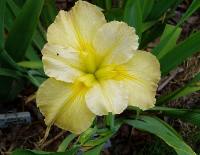|
Seeds of Louisiana Irises have a corky layer for flotation,
so look large when harvested. The stalks will tend to fall over
as time passes, so the pods rest on the ground and the seeds
disperse with the fall rains. Remove the pods as they begin to
turn brown and begin to split at the end. Planting immediately
will produce some seedlings the first fall and also the next
spring. If the seeds are allowed to completely dry, they, as
with many plants, germinate over a long period, a mechanism to
protect the species.
Place the seeds in pots and transplant them once they crowd
the containers. Normally some will bloom the second spring if
they are happy with growth conditions. I place the pots of seedlings
in kiddie pools after germination and gradually raise the water
levels to just over the tops of the pots as the seedlings grow.
Use mosquito dunks. The first fall after germination seedlings
can be separated and lined out. The plants grow normally at the
margin of, or into, shallow water. Here, my garden is slightly
below the surrounding area, so I can flood it periodically when
the rains don't cooperate.
For the purposes of many growers, all the seedlings will probably
be useful. If we are trying to grow "new and improved"
selections, many will be discarded. |

Iris 'Amber River'
(Sloan, 1985) |
